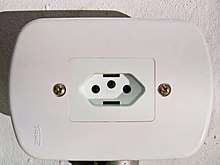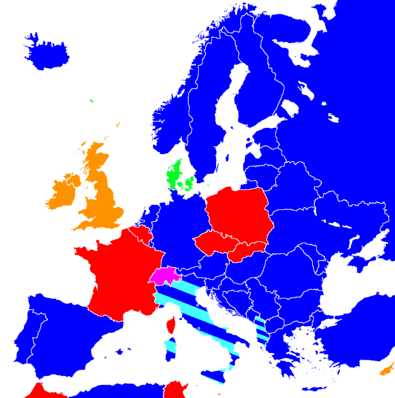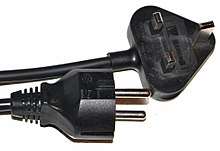IEC 60906-1

IEC 60906-1 is an international standard designed "to provide a standard for a safe, compact and practical 16 A 250 V AC system of plugs and socket-outlets that could be accepted by many countries as their national standard, even if not in the near future."[1] The standard was originally published by the International Electrotechnical Commission in 1986; the current edition is ed2.0 published in 2009. Although it looks similar to the Swiss SEV 1011 plug, its dimensions are different. As of July 2014, only South Africa has introduced a standard (SANS 164-2)[2] based closely on IEC 60906-1. Brazil used it as the basis for its NBR 14136 standard, but this is not compatible with IEC 60906-1. In 2017 the European Union (EU) published recommendations advising against the harmonisation of domestic plug and socket systems in the EU.[3]
Features
IEC 60906-1 plugs and socket-outlets are rated 16 A, 250 V AC and are intended for use on distribution systems having nominal voltages between 200 V and 250 V AC. IEC 60906-1 defines both 3-pin connectors for Class I appliances and 2-pin versions for Class II appliances. (Additional oval-shaped 2-pin connectors for Class 0 appliances defined in the first edition of the standard were never implemented and no longer appear in the current second edition.)
The IEC 60906-1 plugs are smaller than any other European plug with 16 A rating, being only slightly larger than the 2.5 A Europlug and providing much more reliable contact. The sockets are small enough that two can be installed in the space taken by a single Schuko or BS 1363 socket.
The socket has either a 10 mm deep recess or a 12 mm high rim, to exclude incompatible plugs. It ensures that the protective-earth pin establishes contact before the line and neutral pins. Sockets are required to have shutters for the line and neutral apertures.
As it uses the same 19 mm pin spacing as most existing European systems (Schuko, etc.), it would be possible to design sockets that can accept both the traditional plug as well as the IEC 60906-1 Class I and II plugs, thereby enabling a smooth transition to the new system. However, the IEC 60906-1 standard explicitly discourages the use of multi-standard sockets, claiming that such sockets are likely to create safety problems when used with plugs from other countries.
Dimensions
IEC 60906-1 plugs are similar in size and shape to the Europlug, with the front profile being a flat hexagon. They are nominally 35.5 mm wide. The 3-pin Class I plug is 17 mm high, whereas the 2-pin Class II plug is 14 mm high (similar to the Europlug). The parallel side faces are 26 mm apart, and the two pairs of side faces are orthogonal to each other. Like Schuko and Europlug, the line and neutral pin are 19 mm long and on centres spaced at 19 mm. The pins have a diameter of 4.5 mm, intermediate between Schuko (⌀4.8 mm) and Europlug (⌀4.0 mm). In common with the Europlug there is an insulating sleeve around the base of the line and neutral pins. The 3-pin version has a round protective-earth pin of the same length and diameter as the line and neutral pins, but with no insulating sleeve. The protective-earth pin's center is offset 3 mm from the center point between the line and neutral pin.
South African SANS 164-2 standard
South Africa is the only country to have incorporated IEC 60906-1 plugs and sockets into its own national standards as SANS 164-2. SANS 164-2 was made the preferred standard in 2013, replacing the older SANS 164-1 (based on BS 546) but according to the South African Bureau of Standards (SABS) electrotechnical standards development manager, the new plugs and sockets would have "a long, long phase-in period, more than 20 years".[4]
 South African SANS 164-2, quadruple socket
South African SANS 164-2, quadruple socket South African SANS 164-1 (old) & SANS 164-2 (new) sockets in a single plate
South African SANS 164-1 (old) & SANS 164-2 (new) sockets in a single plate Left: Old outlet and plug, Middle: Old and new (multi-standard socket), Right: Socket for new plugs only
Left: Old outlet and plug, Middle: Old and new (multi-standard socket), Right: Socket for new plugs only
Brazilian NBR 14136 standard
According to the National Institute of Metrology Standardization and Industrial Quality in Brazil, the Brazilian Association of Technical Standards "began discussing the creation of a standard for plugs and sockets ... in the 1980s, based on the draft international standard based on IEC 60906-01. It was concluded with wide participation of the manufacturers of plugs and sockets and of electrical and electronic equipment, in July of 1998, with the publication of the norm ABNT NBR 14136."[5]
There are a number of non-compliance issues with IEC 60906-1. Brazil uses both 127 V and 220 V mains supplies, but rather than using the IEC 60906-2 standard for the lower voltage it uses NBR 14136 for both. Whereas IEC 60906-1 specifies a single 16 A rating with 4.5 mm pins, NBR 14136 has both 10 A and 20 A ratings, the 10 A plug has a pin diameter of 4 mm, and the 20 A plug is 4.8 mm. NBR 14136 does not require shutters on the apertures, a further source of non-compliance with IEC 60906-1. The 10 A socket will accept only 10 A plugs, and Europlugs, while the 20 A socket will accept both 10 A and 20 A plugs, plus Europlugs.
 Two-pin charger, three-pin 10 A plug and 10 A socket-outlet conforming to Brazilian Standard NBR 14136.
Two-pin charger, three-pin 10 A plug and 10 A socket-outlet conforming to Brazilian Standard NBR 14136. A 20 A Brazilian socket based on the IEC 60906-1 standard.
A 20 A Brazilian socket based on the IEC 60906-1 standard. Diagram of the a Brazilian NBR 14136 plug with insulated pins.
Diagram of the a Brazilian NBR 14136 plug with insulated pins.
Possibility of acceptance in European Union

In the 1990s the EU requested CENELEC to devise a harmonized plug and socket system for Europe.[6] In 1995 that attempt was abandoned as it was not possible for CENELEC delegates to agree an acceptable solution, CENELEC forecast that converting European households, offices and factories to a common standard would cost about $125 billion.[7]
In response to a suggestion that the European Commission introduce a common system across the whole of the EU, the Commission's Regulatory Fitness and Performance (REFIT) programme issued recommendations in 2017. REFIT found that "the harmonisation of plug and socket outlet systems in Europe, by introducing changes in national wiring legislations (would have) important transitional periods (above 75 years)", and that the cost to "replace the old socket-outlets (and the corresponding plugs of the appliances being used)" was estimated at 100 billion Euro, "generating a huge environmental impact, producing some 700 000 tons of electrical waste".[3] REFIT does not recommend harmonising the plugs and socket-outlet systems in Europe.
Comparison with traditional systems
 BS 1363 (upper) & Schuko (lower) plugs.
BS 1363 (upper) & Schuko (lower) plugs.
Modern injection moulding technology enables robust and safe plugs to be smaller than the Schuko and BS 1363 systems, which were designed in the early and mid 20th century respectively.
BS 1363
The IEC 60906-1 and BS 1363 systems have some common safety features in that plugs and sockets are polarized, and that sockets are required to have shutters for the line and neutral pins. An advantage of the IEC 60906-1 plug types is smaller physical sizes. The IEC 60906-1 plugs are also rated for up to 16 amperes, while the BS 1363 plugs are rated for 13 amperes. The unfused IEC 60906-1 is incompatible with UK law which requires an appropriately rated fuse in the plug to protect the attached flexible cord.[8]
Schuko
The IEC 60906-1 system also avoids the problems of the Schuko and French systems currently used in most of Europe and large parts of Asia:
- Ambiguity between line and neutral on Schuko. Since the Schuko plug is non-polarized it can be inserted upside down, and therefore electronic equipment with Schuko plugs must be fitted with double pole switches and fuse links on both the line and neutral pins in order to be safe. Requiring these extra safety features can add to the manufacturing costs of electronic equipment.
- Large size. The Schuko plug face going into the socket has approximately twice the area of the IEC 60906-1 plugs (ca. 10 cm2 for the Schuko vs. ca. 4.6 cm2 for the earthed IEC 60906-1 plug and 3.8 cm2 for the non-earthed IEC 60906-1 plug.[1] However, the Schuko's large surface area and guide grooves in the recessed socket also allows the combination of a Schuko plug and socket to achieve a very sturdy connection.
- Shock hazard can occur due to mateability of the Class I (earthed) equipment with Schuko plugs being inserted into commonly used two pin (non-earthed) sockets that lack protective-earth contacts. This can for instance be the case with the CEE 7/1 unearthed socket, which either have been or are currently being phased out in most countries.
 Schuko plug partially inserted into a CEE 7/1 unearthed socket. The live pins are in contact while exposed. There is no connection for the earthing contact.
Schuko plug partially inserted into a CEE 7/1 unearthed socket. The live pins are in contact while exposed. There is no connection for the earthing contact.
Swiss plug
The grounded IEC 60906-1 plug (IEC designation "Type N")[9] looks similar to the Swiss SEV 1011 type 12 plug (IEC designation "Type J"). However, the latter has smaller diameter pins (4.0 mm), the ground pin is offset more (5 mm), and it is only rated for 10 A. Therefore there is no compatability between these grounded 3-pin plugs.
The two types of plug systems also differ in that IEC 60906-1 plugs (both 2 pin ungrounded and 3 pin grounded) always have been defined to have partially sleeved line and neutral pins, while the Swiss type 11 (ungrounded) and type 12 (grounded) plugs formerly were allowed to be without partially sleeved pins. However, since 1 January 2013, only type 11 and 12 plugs with partially sleeved line and neutral pins are allowed to be imported and distributed in Switzerland to reduce the risk of electrical shocks.
 Old Swiss type 12 plug without partially sleeved line and neutral pins. Since 2013 only plugs with partially sleeved pins are allowed to be distributed in Switzerland in order to minimize the risk of electric shocks.
Old Swiss type 12 plug without partially sleeved line and neutral pins. Since 2013 only plugs with partially sleeved pins are allowed to be distributed in Switzerland in order to minimize the risk of electric shocks.
See also
References
- 1 2 "IEC system of plugs and socket-outlets for household and similar purposes – Part 1: Plugs and socket-outlets 16 A 250 V a.c." (PDF). IEC. 2009. Retrieved 2018-01-14.
- ↑ Botha, Mark (2014-02-14). "New plug and socket system for SA". Vector. Retrieved 2015-04-20.
- 1 2 "REFIT Platform Recommendations – Internal Market: XII.24.a - "Plugs and sockets"". European Commission. Retrieved 12 January 2018.
- ↑ Blaine, Sue (2014-01-28). "SA to switch to new, safer plugs". Business Day Live. Archived from the original on 2014-01-28.
- ↑ "Padrão Brasileiro de Plugues e Tomadas". Innmetro. 2011. Retrieved 2017-09-06.
- ↑ "Brief history - International standardization of electrical plugs and sockets for domestic use". IEC. Retrieved 13 January 2018.
- ↑ "A Single Plug? Discovering Electricity Was Easier". New York Times. Retrieved 13 January 2018.
- ↑ "Guide to Low-Voltage Switch and Fusegear Devices, page 8". BEAMA. Retrieved 13 January 2018.
- ↑ IEC - World Plugs: Plug Type N
- IEC 60906-1 IEC system of plugs and socket-outlets for household and similar purposes - Part 1: Plugs and socket-outlets 16 A 250 V a.c.
- Brazilian Standard NBR 14136, July 2001.
- South African Standard SANS 164-2:2006.